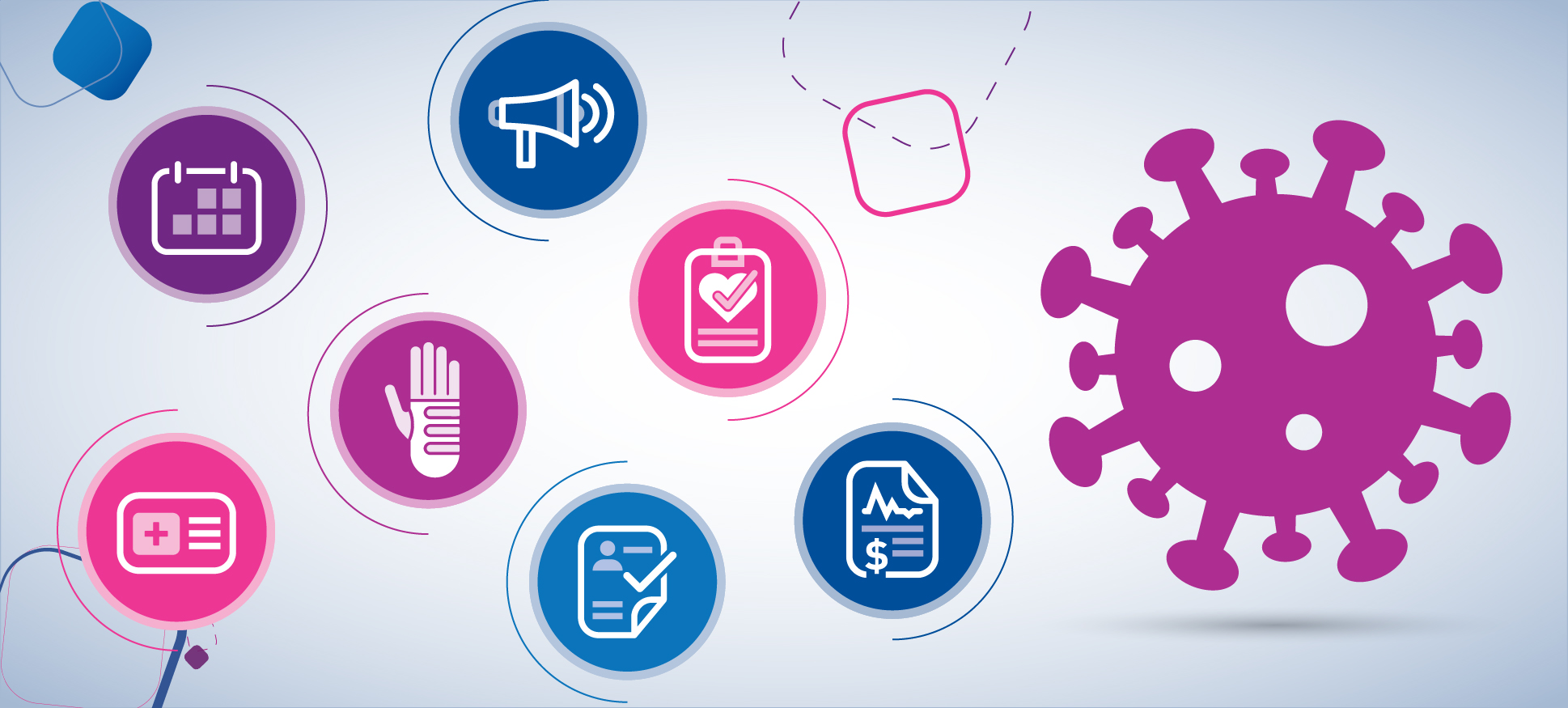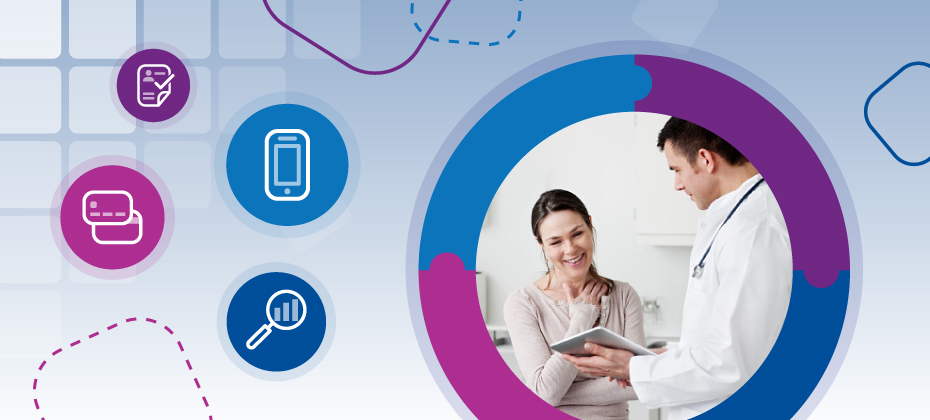Care Management
Learn how data and analytics can power patient-centered engagement strategies to improve population health and reduce healthcare costs.

COVID-19 transformed the patient journey, and it's clear when we evaluate every step. Data and technology gave patients the convenience, flexibility, and control to get care on their terms, and these changes will be here to stay. From marketing to scheduling to payments and more - providers and payers have ample opportunities to respond to these changes and will need to adapt their future strategies accordingly. Self-scheduling, mobile registrations, and automated authorizations are a few examples of tools and technologies that are more than likely to remain prominent in healthcare. What other changes are here to stay? In this new infographic, we take a dive into each of the 7 steps to see how data and technology has impacted the patient journey, and provide strategic recommendations on how providers and payers can adjust post-pandemic: The use of data and digital tools opened up new doors for greater patient access, engagement, transparency, and control. The post-COVID-19 patient journey is going to continue to evolve - payers and providers will need to adapt to keep up with the changes, to ensure that patients experience the best outcomes. To get a deep dive into all of the changes to the patient journey, download our white paper.

This is the fourth in a series of blog posts that will highlight how the patient journey has evolved since the onset of COVID-19. In this post, we address the fourth step – prior authorizations, and helping your patients get the approved care they need. This series will take you through the changes that impacted every step of the patient journey and provide strategic recommendations to move forward. To read the full white paper, download it here. Ask ten physicians how to improve healthcare administration, and they are likely to share dozens of conflicting answers. But if there’s one thing almost all of them can agree on, it’s the need to dramatically overhaul the processes around prior authorizations (PAs) for patient care. Prior authorizations for specific procedures, tests, and medications are designed to reduce financial surprises for patients and providers - while encouraging evidence-based care. The challenge is that criteria for authorizations changes frequently and can be complicated. Unfortunately, due to the COVID-19 pandemic, frequent change and complexity are difficult to manage. After months of avoiding in-person interactions, patients are now flooding back to their providers to catch up on deferred care. In many ways, the increase in volume is to be celebrated: providers are recouping lost revenue and patients are once again receiving necessary services. But with the return of patients comes the return of onerous paperwork, and providers are not entirely prepared to play catch up. In 2021, two-thirds of providers told Experian that they are finding it difficult to keep track of complicated criteria that keep changing during the pandemic. The same number expect to see ongoing challenges with securing authorizations for scheduled elective procedures, a marked increase from just over half of those surveyed last year. As providers, payers, and patients adjust to the new normal of COVID-19, it’s time for providers to streamline operations, increase efficiency, and improve revenue cycle predictability with automated prior authorizations. Coping with the multiplying burdens of prior authorizations Faxes and phone calls dominate the pre-authorization process. Practice staff – or even patients themselves – might spend hours working with multiple payer organizations trying to fill out forms, get more information, or appeal decisions. Without going through this tedious procedure, practices risk claim denials that can significantly impact their revenue cycles and patients may end up with unexpectedly large out-of-pocket bills. Over 80 percent of providers have seen an uptick in prior authorizations since 2020, building on a multi-year trend of increasingly complex PA requirements. In a recent survey from the American Medical Association (AMA), 85 percent of physicians confirmed that the burdens from prior authorizations are “high” or “extremely high,” and are affecting their practice operations. With an average of 40 prior authorizations per week per physician, some practices are spending more than two full working days each week on paperwork, the AMA says. Practices that want to get ahead of PAs will need to take a new approach to preapprovals and health plan relations. Fortunately, innovative automation technologies are available to help. Leveraging automation tools to streamline prior authorizations Prior authorization software can significantly decrease the cognitive burdens and person-power involved in completing PAs. With key features, such as an always-up-to-date knowledge base of current requirements for multiple health plans, staff members don’t have to search for obscure rule changes or the right payer portal to make sure their submissions are accepted the first time around. Exception-based workflows with dynamic work queues can easily guide staff members through convoluted requirements. Advanced status tracking, flags for manual review requirements, and procedure reconciliation tools also ensure that staff are always informed and prepared to take action. As a result, providers and physician groups gain the ability to complete more PAs in less time with a lower risk of errors, resubmissions, or claims denials. Meanwhile, patients can get the timely, evidence-based care they need and are less likely to find unpleasant surprises in their next medical bill. Integrating proactive preapprovals into the patient journey Providers can even take these newfound capabilities one step further to create a fully coordinated, cost-effective administrative experience for their patients. For example, automated Notice of Care tools are the perfect complement to digital prior authorization solutions. With these solutions, providers can send timely and accurate patient admission, observation, and discharge notifications while simultaneously gaining visibility into pending encounters. Uniting Notice of Care tools with data-driven PA strategies will make it simpler to proactively and holistically manage patient flow, anticipate resource allocation, and provide patients with timely and accurate information. As consumers begin to return to their pre-pandemic healthcare habits, it will be more important than ever for providers to get a handle on their administrative requirements and ensure they have the bandwidth to focus on reestablishing strong relationships with patients. With a combination of prior authorization tools and Notice of Care solutions, practices can complete necessary administrative tasks quickly and easily to support efficient, effective, and engaging patient journeys through the continuum of care. Learn more about how Experian Health can help your organization streamline patient access and improve revenue cycle predictability with automated prior authorizations. Download the white paper to learn more about how the prior authorizations process is changing post-pandemic. Missed the other blogs in the series? Check them out: 4 data driven healthcare marketing strategies to re-engage patients after COVID-19 How 24/7 self-scheduling can improve the post-pandemic patient experience COVID-19 highlights an acute need for digital patient intake solutions

The delta variant is still surging – and flu season is about to begin. How can healthcare providers leverage innovative technologies to streamline care and prepare for a potential “twindemic?” The summer of 2021 has not been kind to healthcare professionals. After a brief period of hope that the worst of the COVID-19 epidemic was over, the delta variant started its march across America, flooding hospitals and physician practices with a new wave of seriously ill patients. Autumn and winter look like they might be trouble, too, as delta joins forces with the seasonal flu to form a potential “twindemic.” After a mild season in 2020, many experts are predicting that the flu will reemerge with a vengeance this year as people return to in-person work and school. The combination of the two illnesses could easily overwhelm providers who aren’t prepared with technologies and workflows that allow them to serve patients efficiently and remain responsive to fluctuating demands. As providers look to navigate the coming months, they will need to make sure that they have self-service tools in place to keep patients safe and relieve strain on staff. With a few key digital solutions, resources can be maximized, unpredictable patient volume can be managed effectively, and difficult circumstances won’t slow down operations. Online self-scheduling can improve experiences for patients and staff Online self-scheduling is in high demand because it provides flexibility. patients want to move on with their busy lives without having to sit on hold with a representative. In Experian Health’s recent survey, the State of Patient Access 2.0, more than seven out of ten patients wanted to take the appointment-making process into their own hands, citing the speed and convenience of choosing their own appointments. Providers and physician groups appear eager to oblige. More than 70 percent of providers responding to the survey stated they are planning to offer online appointment tools to improve experiences and manage complex operations as the pandemic continues. The benefits for providers are significant. Online self-scheduling can measurably reduce administrative burdens on staff, allowing practices to reallocate their people power to other high-priority tasks. Giving patients the tools to make appointments may also help to reduce patient no-show rates, which can drain billions of dollars each year from provider organizations. Using self-scheduling tools, patients with transportation issues or concerns about exposure risks may be able to opt for telehealth visits, as opposed to unplanned visits to urgent care centers or the emergency department. This can help protect other consumers and staff from illness while allowing them to manage their own calendars. Mobile patient registration keeps patients safe from exposure during a "twindemic" Shifting patient registration from the clinic to the home can also be beneficial for patients and providers. When patients fill out new forms or update existing information in person, they increase their exposure risk by staying in the waiting room longer than necessary. In contrast, a digital registration accelerator solution offers a quick, touchless, and convenient intake experience on the patient’s own mobile phone. Patients can complete the process in their homes (where they are more likely to have all their personal information at hand), or in the parking lot while waiting for clearance to enter the building. On the provider’s side, automating patient intake improves operational efficiency and avoids errors that come from illegible handwriting and verbal information communicated through masks and plexiglass. Data integrity algorithms and real-time feedback for patients can correct mistakes quickly to ensure high accuracy of patient data – a crucial competency for treatment and reimbursement. Patient portals boost convenience, communication, and security As providers prepare to battle two illnesses instead of just one, practices shouldn’t forget to leverage one of the most important parts of the digital arsenal: the patient portal. Portals are instrumental for staying connected with patients, particularly with the 40% of patients who skipped medical care in the early months of the pandemic. As a complement to necessary in-person care, patient portals offer a convenient way to communicate with providers, complete administrative tasks, and access personal health information at their leisure. Providers must be certain, however, that their portals don’t become avenues for medical identity theft. Healthcare organizations must maintain tight security policies that simultaneously deliver an optimized patient experience. A patient identify-proofing and authentication solution that automates patient portal enrollment while adhering to the high standards of HIPAA and other industry requirements is key. Solid security can reassure patients that sharing digital health information with their trusted providers is safe - fostering more open relationships and leading to better care. Hopefully, fears of a “twindemic” will fizzle as communities continue to take sensible precautions against the spread of COVID-19. However, if the flu does roar back into life, providers must be prepared. Self-service technologies and robust security measures can safeguard practices against the strain of higher-than-expected patient volumes and supporting the continued delivery of high-quality patient care. Learn more about how Experian can help your organization incorporate these new technologies and prepare for a potential "twindemic."

In November 2020, Experian Health conducted a survey to capture consumer and provider attitudes regarding patient access. At the height of the pandemic, patients welcomed telehealth services and maintained their distance from hospital waiting rooms. Providers scrambled to implement and provide digital services that would help them maintain quality care for their patients. In June 2021, we revisited these questions to see if healthcare providers and patients changed their views on the state of patient access: The pandemic has forced rethinking how to “do” healthcare in the digital age. Patients want flexible, convenient, and contactless care; providers need to continue providing these services. Download the white paper for the full survey results and get strategies to plan for the future of healthcare.

COVID-19 changed every aspect of the patient journey – placing unprecedented demands on the healthcare system and accelerating the need for digital transformation industry-wide. Telehealth, touchless engagement, and self-service scheduling became the new normal; however, this created new stress on operations, administration, and finance. While this new normal comes with many challenges, data and digital tools have created greater accessibility, engagement, transparency, and control for patients and providers. In this blog, we examine COVID-19’s impact on the patient journey and explore the digital tools and data that are helping the healthcare industry recover and thrive. To get more insights, read the full whitepaper here. COVID-19 strained the healthcare system more than ever before. To say that COVID-19 challenged the healthcare system is a massive understatement. Seven in 10 patients deferred or canceled treatments during the pandemic, causing disruptions to both revenue and patient engagement. Even behind the scenes, novel diagnostic codes and new sources of information—together with rising inpatient volume and government intervention—affected costs, billing and reimbursements at scale. Patient-provider relationships became much more complex. Many people moved, changed jobs and changed insurance during the pandemic. In fact, an estimated 40 million Americans lost work during the pandemic and just over half of all workers in North America plan to look for new work in 2021. As a result, relationships between physicians and patients became disrupted. While re-engagement is critical for providing care, simply finding patients remains a challenge. The digital experience raised patient expectations. As consumers turned to technology to cope with changes, digital engagement increased in healthcare services and elevated consumer expectations. This trend began before the pandemic: A pre-COVID-19 AARP survey of older adults (50+) found that a majority would prefer to have their healthcare needs managed by a mix of medical professionals and technology. During the pandemic, patients used telehealth to access care from home, mobile registrations to avoid filling out paperwork in the waiting room and digital payment options that made paying bills simple and seamless. Now that patients have experienced telemedicine, self-service scheduling and easy digital payments, there is no going back. Expectations have changed permanently, and providers that don’t offer an updated patient experience may suffer by comparison. Opportunities for better outcomes: transforming the patient journey with digital transformation We looked at key parts of the patient journey where technology is helping healthcare providers engage and care for their patients successfully across the marketing, scheduling, registration, authorization, treatment, claims and payment. Here are a few strategic opportunities for providers to consider post-COVID: 1. Use smart data for better outcomes Third-party data is helping providers find and re-engage patients, deliver more holistic care and facilitate better financial outcomes. For example, integrating data on social determinants of health (SDOH), can provide physicians with a more holistic picture of non-medical factors that may influence medical outcomes, such as a patient’s socioeconomic status. SDOH data can also shine a light on a patient’s ability to pay, which in turn may inspire a wider range of payment options so that more patients can afford care, and more providers can avoid write-offs. 2. Continue using technology and automation for the recovery to come Using digital self-service applications for registration does more than just provide the patient-friendly option of completing paperwork at home (instead of the waiting room). It also eliminates the need for staff hours spent inputting information, reduces the potential for error, and improves efficiency. Advances in automation make it possible for providers to reduce the effort of manual tasks - like sorting through patient records from disparate sources to create a single, comprehensive patient file, or gathering the information necessary to revisit claims authorization for deferred care. Across the board, digitalization provides greater transparency, flexibility, and seamless experiences for patients and providers alike. 3. Clear the path for payments Going digital can help patients and providers better navigate the patient journey, especially when it comes to payments. As many as half of nonretired adults expect long-term financial effects as a result of the pandemic. This makes it more imperative than ever to improve and accelerate authorization, claims, and payment processes so that both patients and providers have a clearer understanding of how care will be paid for. Accurate patient estimates, coverage discovery, automated authorizations, and payments all play a role in creating a better financial experience going forward. Digital transformation gains traction as we look to the future Although the digital transformation was already underway before COVID-19, the pandemic has accelerated the need for data, automation, and self-service tools. Find out how Experian Health can help your organization meet the data challenges of the post-COVID-19 patient journey by downloading our white paper.

"93% of providers say creating a better patient experience remains a top priority, up 3% from last year." - Experian Health's State of Patient Access, June 2021 In November 2020, we surveyed patients and providers for their sentiments on how patient access changed because of the pandemic. During this time, patients welcomed the convenience and control that came with digital, contactless care. Providers knew they needed to improve their digital front door to withstand the financial impact of COVID-19, but implementation was difficult for many organizations. Six months on, and millions of immunized Americans later, the pandemic landscape shifted again. In June 2021, we revisited these questions to find out if patient and provider views have changed - in our State of Patient Access 2.0. Now, patients tell us they feel more confident about returning to facilities, though they still want the flexibility and convenience of digital scheduling, registration, and payment options. Providers feel a growing urgency to make sure online services are sufficiently agile enough to withstand any future surges in COVID-19 case numbers. The findings of the survey reveal four major opportunities to rethink how we “do” healthcare. By innovating and building on the digital advances made possible during the pandemic, providers can create better patient access experiences for the future. To start, providers should: 1. Match consumer expectations for convenient and flexible patient access Our recent survey shows that the pandemic has cemented consumer expectations around convenient access to care. Digital and remote channels for scheduling appointments, completing pre-registration, and making payments have become the new baseline in patient access. Nearly three quarters of patients told us they want to schedule their own appointments online. Providers know this: 93% say creating a better patient experience remains a top priority, up 3% from last year. Online self-scheduling can help providers continue to meet their patients’ demands for flexibility and convenient access to care. Patients can find, book and cancel appointments whenever and wherever they prefer. It’s also a win for providers, who can expect to see a drop in administration errors, no-shows, and denied claims. 2. Streamline prior authorizations as more patients return to care Interestingly, new data reveals that patients are less anxious about in-person care. In 2020, 40% of patients were uncomfortable coming into waiting rooms and seeing their doctor in person. Now, only 16% say they wouldn’t be comfortable in a waiting room. As more patients rush to reschedule deferred care, providers are faced with the challenging combination of higher patient volumes, patients jumping health plans as a result of job losses, and changing payer rules around prior authorizations and coverage checks. Automated pre-authorization and automated coverage checks can relieve the pressure, and help providers save time and resources. 3. Promote price transparency for fewer missed payments An encouraging piece of insight from our latest survey reveals that far fewer patients say they’ve been surprised by their final medical bill. In 2020, more than 50% received a final figure that differed significantly from estimates. Six months later, that figure has dropped to just 14%. Price transparency remains important, and the gap between estimated and final costs seems to be closing. More providers are offering patient billing estimates, with 9 in 10 agreeing that accurate estimates increase the chance of bills being paid on time. Many are also giving patients more options to pay bills earlier in the journey, which has helped to minimize the risk of late and missed payments. Easy and accessible digital options are featured heavily in acquisition and retention plans, and can help drive financial recovery. 4. Tighten up data strategies with better security, quality and insights While our first survey revealed that the sudden shift to digital-first patient access was a shock to the system for many providers, the second study shows that both patients and providers are settling into digital ways of working. But as these digital services become the new baseline, providers must make sure their data strategies are fit for purpose, and prioritize data security, quality and insights. Moving forward, a multi-layered approach will help providers authenticate and secure patient identities. When these identities are enriched with information about how patients are affected by the social determinants of health, providers will be better positioned to offer personalized patient access experiences and support marginalized groups. The future of healthcare is digital. Is your organization prepared? It’s clear from our recent survey that the digital trends that emerged in 2020 are set to continue throughout 2021 and beyond. Download the State of Patient Access 2.0 white paper to get the full survey results and explore how data and digitalization can power a 24/7 patient access experience in your healthcare organization.

“The entire healthcare industry was turned upside down by the pandemic. Procedures were pushed back, insurance companies gave policy holders a lot of mixed information. It has been a mess.” This is what one healthcare executive told us when we surveyed patients and providers on the state of patient access, in June 2021. Changing prior authorizations requirements were particularly messy, and as more patients return to care, there’s a risk they’ll become even more chaotic. During 2020, many in-person healthcare services were canceled, delayed, or avoided for fear of infection. Now, patients feel more comfortable about returning for care. When we first surveyed consumers in November 2020, 58% said they’d wait until COVID-19 subsides before rescheduling. In June 2021, only 19% said they’d wait. Canceled procedures have dropped by half, and while the opportunity to recoup lost revenue is a relief for providers, processing prior authorizations for the sudden influx of patients is a worry. Two thirds of providers say they find it difficult to keep track of changing pre-authorization requirements. Two in three also expect to face issues in securing authorizations for scheduled elective procedures, up from just over half last year. Embedding accurate and efficient workflows will be paramount as patient volumes rise, which means it’s time to rethink the archaic manual processes that often result in delays, errors, and non-compliance. Could automation offer a mess-free way to manage the growing challenge of prior authorizations? Manually managed prior authorizations cost time, money, and quality of care Even before the pandemic, prior authorizations were a thorny issue for healthcare organizations who wanted to offer the best possible care to patients, without risking denied claims. According to the Medical Group Management Association (MGMA), 80%-90% of medical groups say prior authorization requirements have grown year over year. In an ideal world, prior authorizations protect patients from undergoing therapies that are overpriced, ineffective or unnecessary. They assure providers that they’ll be reimbursed for the services they deliver, and confirm that treatments are high-quality, evidence-based, and safe. In reality, while prior authorizations can help incentivize value-based care, the admin and financial burden for providers is growing exponentially. Frequent changes, increasing denials, and lengthy negotiations with payers mean many providers need to employ additional full-time staff to handle prior authorizations. As the cost of drugs soars, they’re forced to lay out huge sums and cross their fingers as they wait to recoup the costs. There was a hint of respite at the peak of the pandemic, when payers lifted many requirements, or extended authorizations already held on file. But these changes took time to filter through, and some providers continued to lose up to two entire business days per week to prior authorizations work during the pandemic. Now, as the pandemic starts to settle, those requirements are back (and growing), and providers are scrambling to re-join the dots using their old, manual processes. As patient numbers surge, traditional manual methods for such an admin-heavy process are straining under the pressure. With so many accounts to authorize, the need for an automated solution is even more apparent. Leveraging automated solutions for speedy, accurate prior authorizations To ensure patients get the care they need and to keep a lid on further revenue loss, hospitals and medical groups should consider tapping into automated authorizations engines. With an integrated Authorizations management system, you can initiate more authorizations in less time, run automated status checks to avoid rescheduling care, keep abreast of changing payer rules, and avoid unnecessary reworking of claims. Users are guided through the workflow, which auto-fills essential real-time payer information. Patient information is populated by the SmartAgent feature, so pre-certification can be progressed quickly behind the scenes. Users only need to step in when clinical questions pop up. Notice of Care (NOC) generates a worklist of all pending patient encounters, to ensure that no payer notification requirements for notice of admission, observation or discharge are missed. Staff can escape the time-suck of repeatedly checking payer websites or calling up payers to verify yet again whether a patient encounter qualifies. Say goodbye to Excel spreadsheets and lengthy calls to payers For organizations worried about rising patient numbers choking their existing manual workflows, switching to an automated system could be a timely move. Chasing paperwork is never a good use of resources, and with the lingering possibility of pandemic flare-ups, automated authorization inquiries could help minimize time spent on tedious manual tasks and running checks with payers. Find out more about how Experian Health’s Prior Authorization software could help your organization minimize the risk of missed reimbursements, and give your team the breathing space needed to focus on maximizing support for patients returning to care.

More than 40% of patients surveyed skipped medical care in the early months of the pandemic, according to a recent study by researchers at the Johns Hopkins Bloomberg School of Public Health. Of those who needed care, 58% missed scheduled preventive care. Similar trends are observed in cancer screening, with appointments for breast, colorectal, and cervical cancers – in some cases dropping by around 80%-90% in March and April 2020, compared to 2019. Diagnostic testing for several cancers also plummeted, as did HPV vaccinations. These trends aren’t unexpected: COVID-19 forced medical facilities to cancel or scale back services, while fear of infection and financial worries kept many patients away. But with most services operating at near-normal capacity again, and the vaccine program tipping the balance in favor of rescheduling care, preventative services are still lagging. Many patients remain reluctant to attend screening and wellness visits, despite the health risks associated with delaying care for potentially serious conditions. Re-establishing a preventive care routine is essential. For patients, getting back on track with earlier diagnosis means more timely treatment and a better chance of recovery. It promises a better financial outlook for patients, payers, and providers alike, who all suffer higher costs when medical conditions escalate. And providers want to get their day-to-day business back on track to smooth out what has been a heavily disrupted workflow and revenue cycle over the last year. Providers must reassure patients that returning to care is safe and necessary. Compassionate and personalized support will be key to making sure patients get the right care at the right time. Automated patient outreach strategies built on comprehensive patient data can help reverse the trends in forgone care. How can data and automation support personalized patient outreach? Kelly E. Anderson, one of the authors of the John Hopkins study, suggests that “physicians can mitigate some of the long-term harmful effects of this forgone care by proactively reaching out to patients who missed care, to try and reschedule the care either in-person or through telehealth.” Automated outreach combined with easy patient scheduling platforms can help providers identify and invite healthcare consumers to get much-needed preventive care appointments back on track. For example: Automation makes scheduling easy for patients and efficient for providers Online scheduling platforms allow patients to reschedule missed appointments at a time and place that suits them. A targeted outreach list of those patients most likely to need screening (for example, based on age, lifestyle, or health risk factors) can be used to send automated booking prompts and reminders by text message or interactive voice response (IVR). It’s simple and convenient for patients and reduces pressure on call center staff. Plus, it generates a wealth of useful real-time data on response rates to pinpoint areas for improvement. With the right data, providers can direct patients to appropriate services For patients that can’t or prefer not to attend their usual healthcare facilities, directing them to telehealth services or alternative venues might be a good option. Similarly, patients with a medical or family history that suggests a higher risk of cancer ought to be prioritized for screening. But you can only do this when you know who those patients are, and what exactly they need. Social determinants of health can be a powerful tool to help providers determine a holistic view of patients’ clinical and non-clinical needs. ConsumerView collates consumer data from over 300 million individuals, across multiple demographic, psychographic and behavioral attributes, so providers know more about the lifestyles and interests to be able to effectively resonate and engage. Data helps create a better patient financial experience Since many patients are worried about the loss of health insurance, outreach efforts might also involve pointing patients towards appropriate financial support. When socio-economic data reveals that a patient is struggling financially, providers can quickly check for missing coverage, offer tailored payment plans, and help obtain charity care if required. Automated outreach can also deliver the upfront information about healthcare pricing that so many patients demand, and help staff collect faster patient payments by providing easy payment links through text and IVR campaigns. Consumer data can inform compassionate patient communications With the majority of patients opting out of scheduled appointments because of concerns about COVID-19 exposure, any invitation to reschedule care should offer plenty of reassurance about hygiene protocols. Some patients may need a gentle nudge to reschedule appointments, so if you can help them feel comfortable visiting facilities and tell them what to expect, they’ll be more likely to return. Offering additional reassurance and support to communities who are traditionally underserved by healthcare services, or who have been harder hit by COVID-19, will be even more important. Best contact information, social determinants of health insight and ethnicity insight can support efforts to promote screening to groups who may face additional barriers to care. With the right data, you can go beyond compassionate messages and choose an appropriate communications channel that’s the right fit for the consumer, too. One thing that hasn’t been hindered by COVID-19 is the trend toward healthcare consumerism. Patients have a choice about which provider they use. Proactively supporting patients to catch up on missed care is a surefire way for providers to stand out as the easy choice.

Knowing that clinical care accounts for only a portion of health outcomes, understanding how patients are affected by social determinants of health (SDOH) continues to gain attention as a critical factor in care delivery. COVID-19 has thrust the issue even further into the spotlight, with socially and economically vulnerable groups hardest hit by the pandemic. At the same time, the expansion of telehealth services over the last year has benefited some marginalized groups, who may feel uncomfortable visiting health facilities or may, for example, sometimes face challenges finding transportation to and from their visits. What’s clear is that when it comes to mitigating the impact of COVID-19’s lingering effects, patient identities based on clinical data alone simply won’t cut it. Providers need a holistic view of patients – both clinical and non-clinical. Many providers do not have updated contact information for the patients they want to engage, in addition to missing patient-level insights such as housing, food, access to technology, transportation and financial stability data that could help better engage patients. Given the many complicated personal and structural barriers that may exist to accessing healthcare, providers lacking SDOH data in patients’ records are risking avoidable readmissions, unnecessary ED visits, poor care quality ratings and denied reimbursements. Understanding patient needs and preferences via lifestyle factors – like occupation and technological knowledge – helps providers improve engagement, outreach and access. The results can be game-changing. The benefits of an enriched, more robust patient record with SDOH Improved certainty of patient needs to achieve healthy outcomes Whether it’s missed appointments, lack of engagement, deferred treatment, or failure to comply with care instructions – if SDOH is the cause, providers need to know. An enriched patient record that includes clearly defined SDOH risks and insights to those risks is invaluable. For example, if a patient record includes recommended engagement strategies suggesting medication delivery, or ensuring medications are with the patient at discharge, due to the patient’s difficulty accessing a pharmacy, negative outcome risk is reduced. Significant provider blind spots that might otherwise interfere with desired health outcomes can be eliminated or extensively mitigated with access to this kind of data. Consumer data gives additional insight useful in risk stratification efforts, allowing care teams to get granular and proactive if, for example, a patient’s lifestyle makes office-hour calls impossible, or if a lack of transportation requires the patient be informed that telehealth is available. Additionally, the data can flag if the patient prefers reminders by text, voice message or email. These considerations make a difference; 80-90% of modifiable contributors to healthy outcomes for a population are regularly attributed to the social, economic and environmental factors that comprise SDOH. Connecting the dots can improve care coordination SDOH data doesn’t just help flag general access issues; it can also help providers dig into specific challenges that may warrant referrals to community programs or additional staffing support. SDOH data may lead to the discovery that a patient is struggling to access healthy, affordable food and prompt a conversation about getting referred to an in-network nutritionist or local food partnership. Patient-specific information can be merged with consumer databases covering a range of socio-economic data, initiating proactive conversations with patients that can solve non-clinical gaps in care. Clarity of the “why” behind patient insights, for better communication and engagement Someone experiencing financial instability as a result of pandemic-related unemployment will expect a different financial conversation than someone who has lived in poverty for their whole life. Further, two patients with high readmission risk can have completely different social determinants of health impacting that risk. Knowing that patients are affected by SDOH is only one piece of the puzzle. Understanding the bigger picture helps create a whole picture and enables personalized, sensitive, and helpful communication. A turn-key SDOH solution that helps define the “why” behind the score avoids analysis paralysis and enables a quick, effective engagement strategy based on what really matters to patients. Supplementing patient surveys with consumer data is also important, as it provides deeper insights and recommendations for engagement strategies. Of course, a connected system only works when the patient identity is accurate and tracks them from service to service. With a universal identity manager, you can have confidence that your teams are all working from a complete, current and insights-rich view of each patient. Find out more about how Experian Health can help your organization make sense of SDOH data for better patient identity management and a more personalized patient experience.
